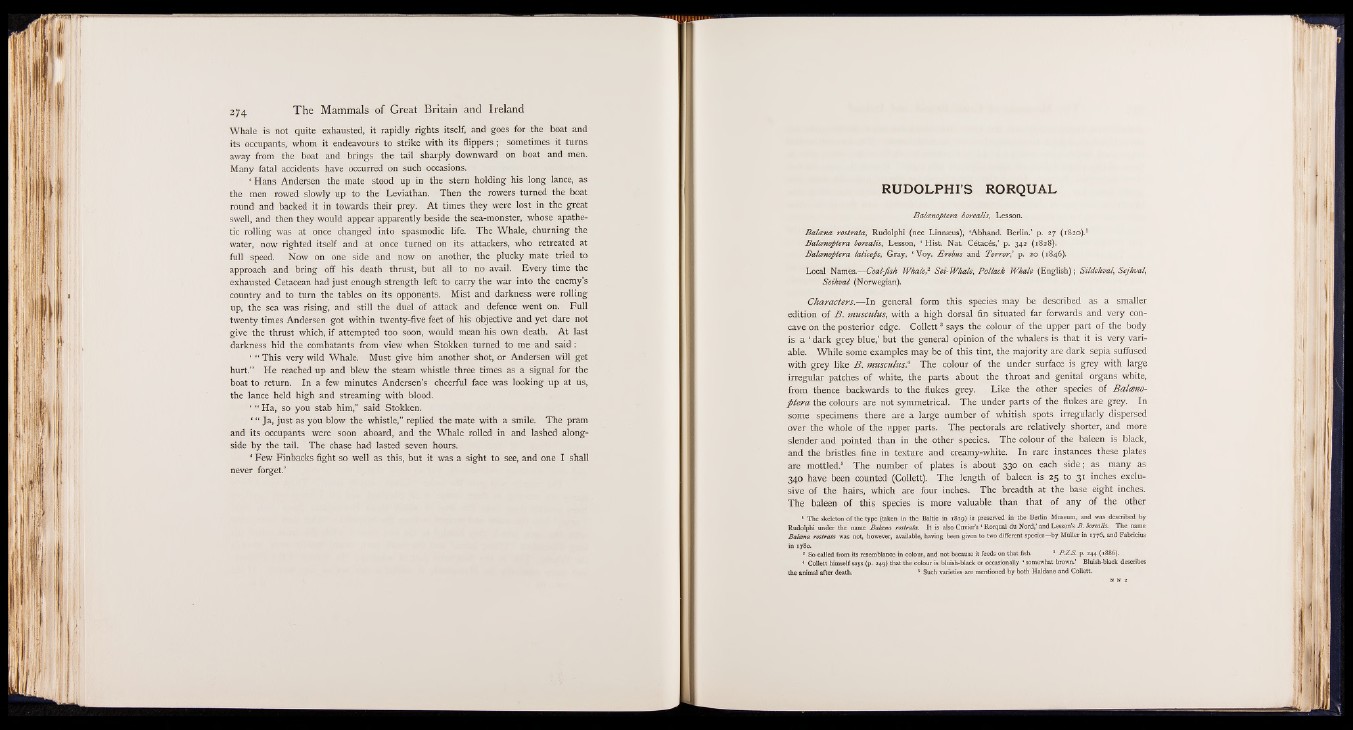
274
Whale is not quite exhausted, it rapidly rights itself, and goes for the boat and
its occupants, whom it endeavours to strike with its flippers; sometimes it turns
away from the boat and brings the tail sharply downward on boat and men.
Many fatal accidents have occurred on such occasions.
* Hans Andersen the mate stood up in the stern holding his long lance, as
the men rowed slowly up to the Leviathan. Then the rowers turned the boat
round and backed it in towards their prey. At times they were lost in the great
swell, and then they would appear apparently beside the sea-monster, whose apathetic
rolling was at once changed into spasmodic life. The Whale, churning the
water, now righted itself and at once turned on its attackers, who retreated at
full speed. Now on one side and now on another, the plucky mate tried to
approach and bring off his death thrust, but all to no avail. Every time the
exhausted Cetacean had just enough strength left to carry the war into the enemy’s
country and to turn the tables on its opponents. Mist and darkness were rolling
up, the sea was rising, and still the duel of attack and defence went on. Full
twenty times Andersen got within twenty-five feet of his objective and yet dare not
give the thrust which, if attempted too soon, would mean his own death. At last
darkness hid the combatants from view when Stokken turned to me and said:
‘ “ This very wild Whale. Must give him another shot, or Andersen will get
hurt.” He reached up and blew the steam whistle three times as a signal for the
boat to return. In a few minutes Andersen’s cheerful face was looking up at us,
the lance held high and streaming with blood.
‘ “ Ha, so you stab him,” said Stokken.
‘ “ Ja, just as you blow the whistle,” replied the mate with a smile. The pram
and its occupants were soon aboard, and the Whale rolled in and lashed alongside
by the tail. The chase had lasted seven hours.
1 Few Finbacks fight so well as this, but it was a sight to see, and one I shall
never forget.’
R U D O L P H I’S RO RQ U A L
Baloenoptera borealis, Lesson.
Baloena rostrata, Rudolphi (nec Linnseus), ‘Abhand. Berlin.’ p. 27 (1820).1
Baloenoptera borealis, Lesson, ‘ Hist. Nat. Cétacés,’ p. 342 (1828).
Baloenoptera laticeps, Gray, ‘ Voy. Erebus and Terror,’ p. 20 (1846).
Local Names.— Coal-fish Whale,2 S ei- Whale, P o lla ck W hale (English) ; Sildehva l, Sejhval\
S eih v a l (Norwegian).
Characters.— In general form this species may be described as a smaller
edition of B . musculus, with a high dorsal fin situated far forwards and very concave
on the posterior edge. Collett8 says the colour of the upper part of the body
is a * dark grey blue,’ but the general opinion of the whalers is that it is very variable.
While some examples may be of this tint, the majority are dark sepia suffused
with grey like B . musculus.4 The colour of the under surface is grey with large
irregular patches of white, the parts about the throat and genital organs white,
from thence backwards to the flukes grey. Like the other species of Balcenofitera
the colours are not symmetrical. The under parts of the flukes are grey. In
some specimens there are a large number of whitish spots irregularly dispersed
over the whole of the upper parts. The pectorals are relatively shorter, and more
slender and pointed than in the other species. The colour of the baleen is black,
and the bristles fine in texture and creamy-white. In rare instances these plates
are mottled.5 The number of plates is about 330 on each side; as many as
340 have been counted (Collett). The length of baleen is 25 to 31 inches exclusive
of the hairs, which are four inches. The breadth at the base eight inches.
The baleen of this species is more valuable than that of any of the other
1 The skeleton of the type (taken in the Baltic in 1819) is preserved in the Berlin Museum, and was described by
Rudolphi under the name Baloena rostrata. It is also Cuvier’s ‘ Rorqual du Nord,’ and Lesson’s B . borealis. The name
Balana rostrata was not, however, available, having been given to two different species— by Müller in 1776, and Fabricius
in 1780.
* So called from its resemblance in colour, and not because it feeds on that fish. 3 P Z .S. p. 244 (1886).
4 Collett himself says (p. 249) that the colour is bluish-black or occasionally * somewhat brown.’ Bluish-black describes
the animal after death. 8 Such varieties are mentioned by both Haldane and Collett.